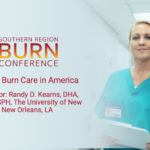Abstract | March 2, 2021
COVID-19 and Burn Care in America
Learning Objectives
- Understand of the three principles of managing each disaster: staff, space and supplies. One aim of this program will be to provide feedback regarding these three areas, as they relate to burn care.
Introduction: A worldwide pandemic currently grips much of the global healthcare system. This pandemic is rivaled in the past 150 years only by the 1918 flu pandemic.
Planning and preparedness efforts have been ongoing for disasters specifically affect significant numbers of patients with burn injuries. As such, much effort has included a focus on the three critical elements consistent with an all-hazards approach: staff, space, and supplies. While COVID19 is not a Burn Mass Casualty Incident (BMCI) per se, it has profoundly impacted the profession and our ability to care for patients.
Only later, when we can look back to this period, will we know at what stage we are in regarding the magnitude of the disaster. Furthermore, the impact has been inconsistent, with some locations being overwhelmed while leaving others prepared for a surge that never came (at least at this point).
This report will briefly examine the first 12 weeks of data collected around North America regarding the impact COVID19 had on burn care.
Methods: A (short) six question survey was distributed to leaders from each burn center in the ABA each week for 12 consecutive weeks starting mid-March 2020. The survey primarily focused on staff, space, and supplies as it related to the burn center with a final question focusing on the healthcare system. Results: We received replies from approximately 50 burn centers each week during the survey. The respondents represented each of the regions of the US and Canada.
Results: We received replies from approximately 50 burn centers each week during the survey.
The respondents represented each of the regions of the US and Canada.
Respondents who reported: a “mild problem, not impacting care.”
Staff range from 24% (week 12) to 39% (week 5).
Supply range from 0% (week 12) to 63% (week 1).
Space range from 26% (week 1) to 25% (weeks 3 and 4)
Respondents who reported: a “moderate problem threatening care”
Staff range from 7% (week 12) to 19% (week 3).
Supply range from 0% (week 12) to 30% (week 1).
Space range from 6% (week 7) to 19% (week 3).
The third section focused on general surge capacity at the healthcare system where the burn center is located. Surge capacity added to augment space needs for the healthcare system ranged from: a low of 16% week 12 to 47% week 3.
Conclusions: While this disaster had little to do with burn-injured patients, it substantially reduced capacity to provide care for all disciplines as many systems diverted resources to confront the crisis. The costs are yet to be fully measured, but our efforts to focus on investing in disaster preparedness are essential for long term continuity of care. Early into the disaster, supply was the most critical deficit. As the supply chain was rebuilt, and space was acquired, a variety of solutions were employed to solve the staffing shortage. Long term, the staff component of this disaster will pose the greatest concern.
Applicability to Practice: This disaster reminds us of the value to consider all hazards that also limit our ability to care for patients with burn injuries.
References and Resources
- Committee on Crisis Standards of Care ATfI, Triggers, Board on Health Sciences P, Institute of M. In: Hanfling D, Hick JL, Stroud C, eds. Crisis Standards of Care: A Toolkit for Indicators and Triggers. Washington (DC): National Academies Press (US). Copyright 2013 by the National Academy of Sciences. All rights reserved.; 2013.
- Barillo DJ, Dimick AR, Cairns BA, Hardin WD, Acker JE, 3rd, Peck MD. The Southern Region burn disaster plan. J Burn Care Res. 2006;27(5):589-595.
- Kearns R, Holmes Jt, Cairns B. Burn disaster preparedness and the southern region of the United States. Southern medical journal. 2013;106(1):69-73.
- Hick JL, Einav S, Hanfling D, et al. Surge capacity principles: care of the critically ill and injured during pandemics and disasters: CHEST consensus statement. Chest. 2014;146(4 Suppl):e1S-e16S.
- Hick JL, Hanfling D, Cantrill SV. Allocating scarce resources in disasters: emergency department principles. Annals of emergency medicine. 2012;59(3):177-187.
- Hanfling D, Hick JL, Cantrill SV. Understanding the role for crisis standards of care. Annals of emergency medicine. 2012;60(5):669-670; author reply 670-661.
- Kearns RD, Holmes JHt, Alson RL, Cairns BA. Disaster planning: the past, present, and future concepts and principles of managing a surge of burn injured patients for those involved in hospital facility planning and preparedness. J Burn Care Res. 2014;35(1):e33-42.
- Kearns RD, Conlon KM, Valenta AL, et al. Disaster planning: the basics of creating a burn mass casualty disaster plan for a burn center. J Burn Care Res. 2014;35(1):e1-e13.
- Kearns RD, Cairns BA, Cairns CB. Surge Capacity and Capability. A Review of the History and Where the Science is Today Regarding Surge Capacity during a Mass Casualty Disaster. Front Public Health. 2014;2:29.
- Kearns RD, Marcozzi DE, Barry N, Rubinson L, Hultman CS, Rich PB. Disaster Preparedness and Response for the Burn Mass Casualty Incident in the Twenty-first Century. Clinics in plastic surgery. 2017;44(3):441-449.

